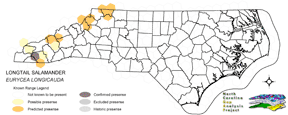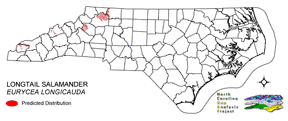
| Taxa: |
| Order: |
| Family: |
| Amphibia |
| Caudata |
| Plethodontidae |
| NatureServe Global Rank: |
| NatureServe State (NC) Rank: |
| G5 |
| S5 |
| Federal Status: |
| NC State Status: |
| --- |
| --- |


| Land Unit |
| US Fish & Wildlife Service |
| US Forest Service |
| US National Park Service |
| US Department of Defense |
| NC State Parks |
| NC University System |
| NC Wildlife Res. Com. |
| NC Forest Service |
| NC Div. of Coastal Mgmt. |
| Local Governments |
| Non-Governmental Org. |
| Other Public Lands |
| Private Lands |
| GAP Status 1-2 |
| All Protected Lands |
| Statewide |
| Hectares |
| 0.00 |
| 13,161.24 |
| 80.91 |
| 3,589.92 |
| 1,873.53 |
| 0.00 |
| 455.94 |
| 0.00 |
| 0.00 |
| 0.00 |
| 47.61 |
| 0.00 |
| 48,198.96 |
| 6,362.10 |
| 19,128.24 |
| 67,408.11 |
| Acres |
| 0.00 |
| 32,522.13 |
| 199.93 |
| 8,870.88 |
| 4,629.59 |
| 0.00 |
| 1,126.65 |
| 0.00 |
| 0.00 |
| 0.00 |
| 117.65 |
| 0.00 |
| 119,102.20 |
| 15,721.09 |
| 47,266.90 |
| 166,569.03 |
| % of Dist. on |
| Prot. Lands |
| 0.0 % |
| 68.8 % |
| 0.0 % |
| 18.8 % |
| 9.8 % |
| 0.0 % |
| 2.4 % |
| 0.0 % |
| 0.0 % |
| 0.2 % |
| 0.2 % |
| 0.0 % |
| 0.0 % |
| 33.3 % |
| ----- |
| ----- |
| % of Dist. on |
| All Lands |
| 0.0 % |
| 19.5 % |
| 0.1 % |
| 5.3 % |
| 2.8 % |
| 0.0 % |
| 0.7 % |
| 0.0 % |
| 0.0 % |
| 0.0 % |
| < 0.1 % |
| 0.0 % |
| 71.5 % |
| 9.4 % |
| ----- |
| ----- |
|
In North Carolina, isolated records are from the Watauga, Nantahala, and Little Tennessee watersheds (Martof et al. 1980). Found at rocky streams, seeps, springs, and in bottomlands and damp caves (Martof et al. 1980). Mines, ravines and other damp, rocky situations are also used (Petranka 1998). In much of its range outside of North Carolina, it is associated with limestone and shale streambeds (Martof et al. 1980). It is usually found close to the margins of streams, but is not restricted to stream borders and will occasionally be found away from water in deep forested habitats or in isolated forest pools (Petranka 1998). Rocky banks of streams, seeps, or springs provide the salamander with small overhangs or rock stacks form which to suspend its eggs (Martof et al. 1980). NATURE SERVE GLOBAL HABITAT COMMENTS: Streamsides, spring runs, cave mouths, abandoned mines; also ponds in northern New Jersey (Conant and Collins 1991). May disperse into wooded terrestrial habitats in wet weather. Hides in rock crevices and under rocks, logs, and other debris. Eggs are laid in underground crevices associated with springs, temporary pools, and streams; under rocks in streams; in woodland ponds; or are attached to objects in or above water in caves. |
| Code | Name | Description | NC Natural Heritage Program Equivalent |
| 232 | Xeric Pine-Hardwood Woodlands and Forests | Mixed forest dominated by yellow pines with drier oaks including southern red, post, and chestnut oaks. | Dry Oak Hickory Forest |
| 230 | Piedmont Mesic Forest | American Beech - Red Oak - White Oak Forests. | Mesic Mixed Hardwood |
| 384 | Piedmont/Mountain Mixed Bottomland Hardwood Forests | Includes temporarily to seasonally forests dominated by hardwood species. Hardwoods include sweetgum, red maple, sycamore which co-occur in a mosaic of bottomland and levee positions. Includes alluvial hardwood forests in the mountains. Hemlock and white pine may occur as inclusions, but are generally mapped separately. | Piedmont/Mountain Alluvial Forest, Piedmont/Mountain Levee Forest |
| 383 | Piedmont Mixed Successional Forest | Generally loblolly mixed with successional hardwoods. Sweetgum, tulip poplar and red maple are common co-dominants in these successional forests. | No equivalent |
| 228 | Piedmont Dry-Mesic Oak and Hardwood Forests | Primarily oak dominated forests, white oak is often dominant, with co-dominants including . Also represented by sweetgum and tulip poplar dominated forests. | Dry Mesic Oak Hickory Forest, Basic Oak Hickory Forest, Dry Oak Hickory Forest |
| 222 | Piedmont Dry-Mesic Pine Forests | Loblolly dominated forests resulting from succession following clearing. This type occurs on all moisture regimes following disturbance with the exception of the extremely xeric sites. | No equivalent |
| 382 | Dry Mesic Oak Pine Forests | Mixed forests of the coastal plain and piedmont. Includes loblolly pine with white, southern red and/or post oak and loblolly with water oak. On basic sites of the piedmont, eastern red cedar may co-occur with post, black, and blackjack oaks. | Dry Mesic Oak Hickory Forest, Xeric Hard Pan Forest, Chestnut Oak Forest, Dry Mesic Oak Hickory Forest, Dry Oak Hickory Forest |
| 220 | Piedmont Xeric Pine Forests | Dry to xeric pine forests dominated by Virginia pine, shortleaf pine or Eastern Red Cedar. | Pine Oak Heath |
| 226 | Piedmont Xeric Woodlands | Generally post and blackjack oak dominated woodlands. White ash and pignut hickory can be found in combination with Eastern red cedar on glades. | Xeric Hardpan Forest |
| 36 | Successional Deciduous Forests | Regenerating deciduous trees with a shrub stature. Commonly dominated by sweetgum, tulip poplars and maples. | No equivalent |
| 517 | Hemlock Floodplain Forest | Alluvial forest with hemlock and/or white pine in mountains and western piedmont. Hydrology is generally temporarily to seasonally flooded. | Canada Hemlock Forest |
| 522 | Northern Hardwoods | High Elevation forests including yellow birch, American beech, and yellow buckeye. Includes forests with Hemlock and Yellow Birch. | Northern Hardwoods Forest, Boulderfield Forest |
| 525 | Appalachian Oak Forest | A variety of oak forest types including Black, White, Scarlet Oaks in dry to mesic situations. Includes forests historically co-dominated by American Chestnut. | High Elevation Red Oak Forest, Montane White Oak Forest |
| 526 | Appalachian Cove Forest | Mixed Mesophytic forests of the mountains. Includes tuliptree, basswood, yellow buckeye and surgar maple. This class is mapped to include cove forests dominated or co-dominated by hemlock. | Rich Cove Forest, Acidic Cove Forest |
| 527 | Appalachian Hemlock | Upland hemlock forests of the moutains region. Vary from side slopes to steep slope positions. | Canada Hemlock Forest |
| 528 | Appalachian Xeric Pine Forest | Pine forests and woodlands on xeric sites. A variety of pines, including Virginia, Shortleaf, Eastern White Pine, Table Mountain and Pitch pine. Often small areas of dense pine within a matrix of Xeric Oak-Pine Forests. | Pine Oak Heath |
| 529 | Appalachian Xeric Mixed Forest | Mixed forests with Virginia, Shortleaf, Eastern White Pine, Table Mountain and Pitch pines in combination with xeric oak species. Oaks include, white, Southern Red, black, and rock chestnut. | Pine Oak Heath |
| 530 | Appalachian Xeric Deciduous Forest | Deciduous forests in the mountains dominated by Xeric Oak species. Species include, white, Southern red, black, and rock chestnut. | High Elevation Red Oak Forest, Montane White Oak Forest |
| 533 | Appalachian Swamp Forest | Evergreen and deciduous forests with saturated hydrologies. This class may contain a variety of trees species, including hemlock - red maple, pitch pine, and white pine forests. | Swamp Forest-Bog Complex, Southern Appalachian Bog, Southern Appalachian Fen |
| 534 | Appalachian Wet Shrubland/ Herbaceous | Saturated shrubs and herbaceous vegetation. Often mapped as an inclusion in Appalachian Swamp Forest. | Southern Appalachian Bog, Southern Appalachian Fen |
|
Conant, R. and J. T. Collins. 1991. A field guide to reptiles and amphibians:eastern and central North America. Third edition. Houghton Mifflin Co., Boston, Massachusetts. 450 pp.
Ireland, P. H. 1979. Eurycea longicauda. Cat. Am. Amph. Rep. 221.1-221.4. Petranka, J. W. 1998. Salamanders of the United States and Canada. Washington DC: Smithsonian Inst. Press. Valentine, B. D. 1962. Intergrading populations and distribution of the salamander EURYCEA LONGICAUDA in the Gulf states. J. Ohio Herpetol. Soc. 3(3):42-51. Barbour, R. W. 1971. Amphibians and reptiles of Kentucky. Univ. Press of Kentucky, Lexington. x + 334 pp. Minton, S. A., Jr. 1972. Amphibians and reptiles of Indiana. Indiana Academy Science Monographs 3. v + 346 pp. Conant, R. 1975. A Field Guide to Reptiles and Amphibians of Eastern and Central North America. Second Edition. Houghton Mifflin Company, Boston, Massachusetts. xvii + 429 pp. Mount, R. H. 1975. The Reptiles and Amphibians of Alabama. Auburn University Agricultural Experiment Station, Auburn, Alabama. vii + 347 pp. Behler, J. L., and F. W. King. 1979. The Audubon Society field guide to North American reptiles and amphibians. Alfred A. Knopf, New York. 719 pp. Martof, B. S., W. M. Palmer, J. R. Bailey, and J. R. Harrison, III. 1980. Amphibians and reptiles of the Carolinas and Virginia. University of North Carolina Press, Chapel Hill, North Carolina. 264 pp. Green, N. B., and T. K. Pauley. 1987. Amphibians and reptiles in West Virginia. University of Pittsburg Press, Pittsburg, Pennsylvania. xi + 241 pp. |
For more information please contact them at:
NC-GAP Analysis Project
Dept. of Zoology, NCSU
Campus Box 7617
Raleigh, NC 27695-7617
(919) 513-2853
www.basic.ncsu.edu/ncgap